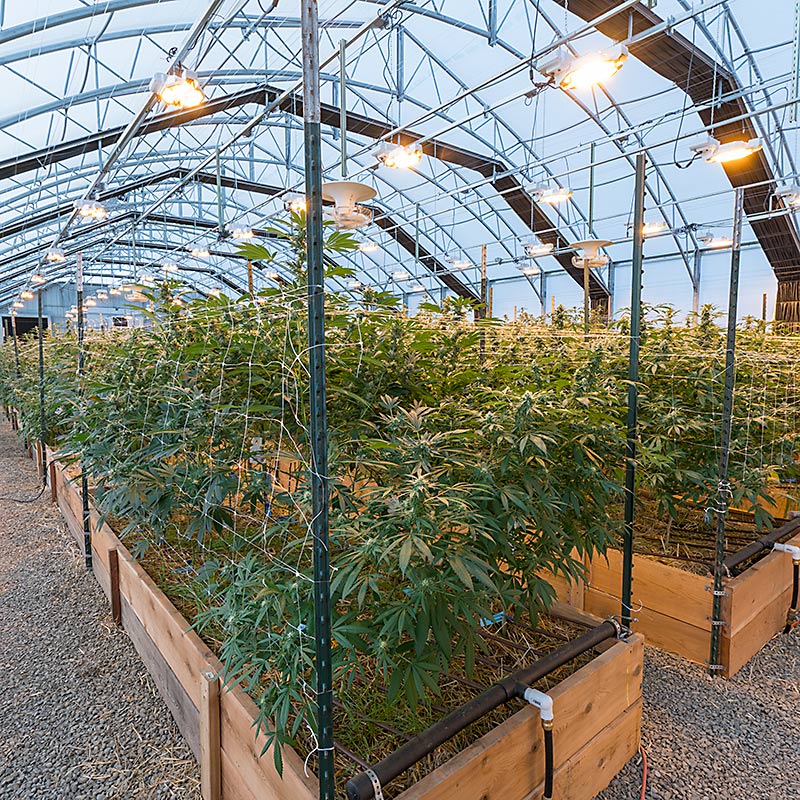Part – 1
Growing grower
As the Oregon cannabis industry grows, sofresh farms continues to be at the forefront in growing fine craft cannabis. Our new, state-of-the-art greenhouse uses the latest materials and technology allowing us to grow superior plants with the least environmental impact. So why did sofresh farms decide to go with a light deprivation (light dep) greenhouse instead of traditional indoor growing methods? What was the build experience like?
Why light dep?
Light dep greenhouses are slowly becoming the new standard in cannabis growing. Indoor growing is just not as efficient, and the quality of herb can’t compete with the benefits natural sunlight gives. There’s something about the sun that gives cannabis that little extra boost plants can’t get from artificial light. We’ve consistently hit higher THC% scores in our greenhouse than our indoor rooms.
The Budget
The first step in building a light dep greenhouse is figuring out your budget. You can’t spend what you don’t have. Everything is a balancing act trying to configure the best possible solution with the least amount of money. One thing we learned right away is that estimates are not always accurate! There’s always going to be unforeseen costs no one planned for. If I were to advise someone figuring out their budget I’d recommend adding everything up, then double it. If things go wrong, you’ll still come in within budget. If things go as planned… Just kidding! Things never go as planned.
The Plan
Many of the decisions made are based on state cannabis laws. Oregon uses canopy size rather than plant number, so our plan centered on using the maximum amount of space allowed. We decided to go with a five-row layout focused on maximum light exposure and easy maintenance.
The Building
For the structure, we shopped around locally and found another farm with a new, unbuilt greenhouse ready for assembly. We made a deal and before you know it, we were setup with an entire greenhouse kit, ready for assembly. There are many good manufactures today and all it takes is a little shopping to find the right deal for yourself.
Light on
After figuring out the ideal structure and laying out the growing space, the next step is to plan the light setup. The crucial question is, how much power do you have? Often, the number of lights is dependent more on power or heat limitations than budget. Setting up 100 lights won’t do much good if they pop a breaker every time they turn on. It’s also important to factor in enough power to run the light-dep tarp, fans and dehumidifiers, all at the same time. We’ve always experienced power issues on our farm. It seems that no matter how much power we have, it’s never enough. Our new greenhouse demands a massive amount of power. We had to carefully map out our electrical needs or run the risk of constantly popping circuit breakers.
The right environment
One of the most important aspects of the greenhouse plan is mapping out the environmental system. Oregon summers bring hot days while winters may drop below freezing. We had to be prepared for any situation no matter how extreme.
For the long hot summer days, we needed a way to intake fresh, cool air while exhausting excess heat. Our Redhouse has a large, programmable roof vent along with two huge fans that look more like jet engines than exhaust fans. With the extreme ventilation capabilities, we can keep fresh air coming in, hot air going out and our girls happy.
Preparing for Winter is equally as challenging. Depending on your location, you may need to supplement heat. There are a few different methods to do so, but we ended up choosing a propane heater to keep temps up. Of course, a large heater requires an even larger propane tank. Here on the farm, we have a 1,000-gallon tank to heat our structures, that’s a lot of BBQs!
H2O
Another environmental factor to consider is water. Cannabis plants require a large source of good, clean water. No matter your location, water always contains a certain amount of minerals that could possibly affect the way your plants grow and absorb nutrients. On our farm, we’re able to pull water from our own well. Because our water isn’t treated by the city, we had to install our own filtration system to pH our water and remove any excessive minerals. Each case is different, and proper water tests will provide solid data to decide the best solution for your needs.
Complete control
All these components need to be controlled by something. There are many environmental control systems available nowadays and the choice can seem overwhelming. Any good solution should automate most environmental aspects while being easy to use. Most state-of-the-art systems can be controlled using a phone or tablet. Once connected, these high-tech systems will monitor temps and humidity, making changes whenever needed. We can even turn our lights on and off from another state!
Next steps
With the plan complete, the next step is physically building the Redhouse. This tends to be the most arduous phase of the entire project. If things go well, it won’t take long, but life happens, and sometimes your neat deadline winds up being pushed back. We experienced it all. Be sure to read about it in part 2 of “The Redhouse”.








